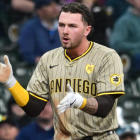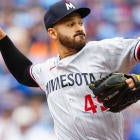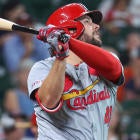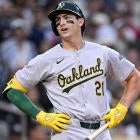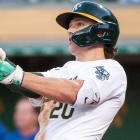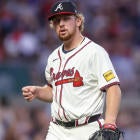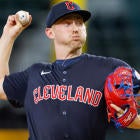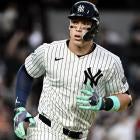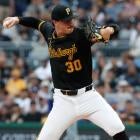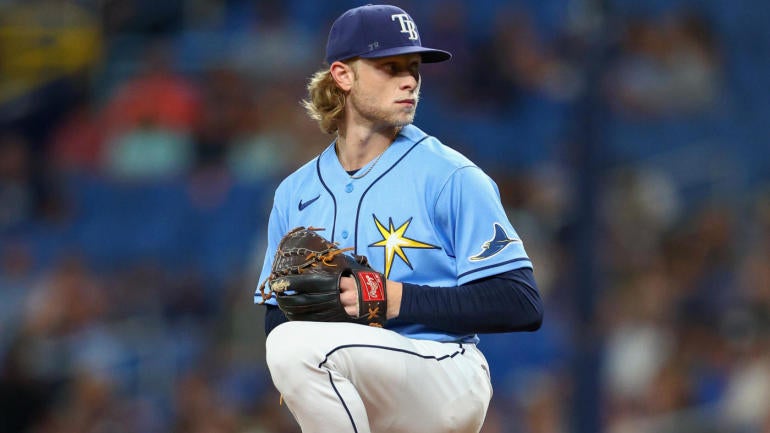
I have some bad news for those who've been stashing Jasson Dominguez. He has a moderate oblique strain and is likely to miss upward of a month.
I also have bad news for those who've been stashing Jackson Holliday. He has elbow inflammation and is likely to miss ... well, it's hard to say, actually. But seeing as he wasn't tearing the cover off the ball before the injury, I suspect he's more than a month away of playing in the big leagues as well.
It's hard to list them among the top five prospects to stash given those suggested timelines. Then again, it's hard to identify five prospects who are actually worth stashing regardless. It was already a stretch for those two, especially Holliday.
I will say that the top two in this week's Five on the Verge, James Wood and Noelvi Marte, should be stashed in every Rotisserie league, at least, given how many hitters need to be rostered in that format. But beyond those two, just understand that stashing is more a suggestion than an imperative.
FIVE ON THE VERGE
(These are the prospects most worth stashing in redraft leagues.)
James Wood, OF, Nationals
2023 minors: .262 BA (473 AB), 26 HR, 18 SB, .873 OPS, 65 BB, 173 K
2024 minors: .351 BA (168 AB), 9 HR, 10 SB, 1.052 OPS, 36 BB, 37 K
Wood remained at the top of my Five on the Verge even while sitting out three weeks with a hamstring injury, which should tell you that the prospect reserve is pretty thin right now and that, within it, Wood is far and away of the greatest interest in Fantasy. He went 0 for 2 with a walk in his first game back Tuesday and was notably playing left field instead of center. This is the ostensibly because fellow top prospect Dylan Crews is at Triple-A Rochester now and could use the reps in center more, but Mark Zuckerman of MASN characterized it another way:
"The implication: With Wood perhaps a few weeks away from making his major league debut, the Nationals are prepping him to play left field alongside Jacob Young and Lane Thomas."
In this scenario, the DH spot would still be available for Jesse Winker. Eddie Rosario would be out of a job, but he has cooled off since his early-May surge and is playing less regularly already. Before any of that happens, though, Wood first has to prove that his timing is down at Triple-A and that he's able to elevate the ball enough to do damage against big-league pitchers. He's made such strides as a hitter already this year that I suspect he'll do so before the end of June.
Noelvi Marte, 3B, Reds
2023 minors: .279 BA (348 AB), 11 HR, 18 SB, .812 OPS, 43 BB, 70 K
2023 majors: .316 BA (114 AB), 3 HR, 6 SB, .822 OPS, 8 BB, 25 K
2024 minors: .226 BA (31 AB), 1 2B, 1 SB, 0 BB, 8 K
MLB has granted Marte two weeks to get up to speed in the minors so he can be activated as soon as his PED suspension ends on June 27, and so far ... not so good. But whatever, the whole point is that he's not expected to be game-ready yet. The Reds are so desperate for help that I doubt they'll prolong the "rehab assignment" if Marte doesn't appear to be all the way back at the end of another week.
What I mean by "desperate for help" is that they've been forced to rely on a revolving door of objectionables both in left field and at DH. Matt McLain isn't coming back anytime soon. Christian Encarnacion-Strand may not be coming back at all. Marte would presumably spend most of his time at third base, bumping Jeimer Candelario to first base and Spencer Steer to left field, with all of them rotating in and out of DH as needed.
Part of what makes Marte such an attractive prospect to stash is that he's already semi-proven in the majors, which counts for a lot in a year when so many first-time call-ups are having such a difficult time breaking through. You see the numbers he put up in six weeks of MLB duty. They were backed up by a 91.3 mph average exit velocity. Even in that small sample, he hit a ball as hard as 115.6 mph, which was good enough to place him in the 96th percentile for max exit velocity.
Shane Baz, SP, Rays
Career majors: 4.02 ERA, 1.12 WHIP, 40 1/3 IP, 12 BB, 48 K
2024 minors: 4.60 ERA, 1.50 WHIP, 31 1/3 IP, 18 BB, 31 K
Though only nine starts into his career, Baz was thought to be a fixture in the Rays rotation at the time he succumbed to Tommy John surgery midway through 2022. Most publications had him as the No. 2 pitching prospect coming into that season, behind only Grayson Rodriguez, and he had put together a 2.61 ERA, 0.97 WHIP and 10.9 K/9 through his first eight career starts (things went sideways in the ninth, for obvious reasons). So it was mildly surprising when he was optioned rather than activated at the end of his rehab assignment in late May. I say "mildly" because the Rays didn't really have an opening in their rotation and also because Baz didn't appear ready to return yet, having put together a 7.71 ERA, 1.96 WHIP and 5.0 K/9 through five minor-league starts.
We can say the latter has changed, at least. Over his past three starts at Triple-A Durham, Baz has a 1.20 ERA, 1.00 WHIP and 13.2 K/9, boasting a 68 percent strike rate and 16 percent swinging-strike rate that would both rate as elite. His fastball is back to averaging 96 mph and peaking at 99 mph just like it was before the injury, and the control has come around as well. Judging by their usage, the slider may be a little ahead of the curveball right now (he relies on both for whiffs), but he's cleared the biggest hurdles in his recovery and is closing in on a return. The Rays still don't yet have a clear opening in the starting rotation, but Aaron Civale and Zack Littell may be pitching their way out of it.
Christian Scott, SP, Mets
2023 minors: 2.57 ERA, 0.86 WHIP, 87 2/3 IP, 12 BB, 107 K
2024 minors: 2.82 ERA, 0.89 WHIP, 38 1/3 IP, 9 BB, 52 K
2024 majors: 3.90 ERA, 1.08 WHIP, 27 2/3 IP, 6 BB, 25 K
The good news for Scott is that he was basically everything the Mets wanted him to be during his five-start stint earlier this season. The bad news is that they still have more to see from Tylor Megill and David Peterson, who have at least managed to hold their own since returning from injury. The Mets, like every other team, aren't in the habit of eliminating rotation options before they need to, and it's clear they view Scott as the extra piece rather than the missing one.
"We have a lot of off days coming up, so a five-man rotation is best for us moving forward,'' manager Carlos Mendoza said when asked about Scott last week.
It's still possible Scott overtakes one of Megill and Peterson on performance alone, particularly since Megill and Peterson themselves still have minor-league options, but their performances haven't been so disparate yet. History suggests, however, that one of of Megill and Peterson will eventually wear out his welcome (by which I mean neither has a particularly good track record in majors), so as long as Scott continues to cruise at Triple-A Syracuse, he's in a good position for stashing in Fantasy. Since returning there in early June, he has 2.08 ERA, 1.23 WHIP and 11.1 K/9 across three starts.
Coby Mayo, 3B, Orioles
2023 minors: .290 BA (504 AB), 29 HR, 45 2B, .973 OPS, 93 BB, 148 K
2024 minors: .301 BA (193 AB), 16 HR, 15 2B, 1.018 OPS, 19 BB, 59 K
It's not clear that Mayo is the fifth-best prospect to stash over his Triple-A Norfolk teammate Heston Kjerstad or the Marlins' Max Meyer, but I'm choosing to write about him because something is actually happening with him. What's happening is he's playing again, having recovered from a fractured rib suffered in mid-May. You may remember the debate at that time was whether the Orioles should give Mayo a look in the majors before bringing back Jackson Holliday, but seeing as Holliday is the injured one now, having recently gone on the minor-league IL with elbow inflammation, it's not much of a debate anymore.
Of course, Mayo will need to get back up to speed at Triple-A first, but provided he does, Jordan Westburg could shift over to second base full-time to accommodate Mayo at third. Mayo offers the sort of right-handed power that would play even at Camden Yards, with its deep left field fence, having delivered an average exit velocity of 93.1 mph and a max exit velocity of 114.9 mph. Those readings are comparable to Marcell Ozuna this year.
FIVE ON THE PERIPHERY
(Here are some other prospects doing something of note.)
Jhonkensy Noel, OF, Guardians
2023 minors: .220 BA (519 AB), 27 HR, .723 OPS, 49 BB, 145 K
2024 minors: .299 BA (241 AB), 17 HR, .946 OPS, 18 BB, 57 K
Last week, I highlighted Johnathan Rodriguez as a potential source of right-handed power for the Guardians, and he's since gotten the call the majors (if only in the short-term with Jose Ramirez on paternity leave). But there's another at their Triple-A affiliate who could also meet that need, and it's Jhonkensy Noel, who first gained attention as a 19-year-old hitting .340 with a 1.005 OPS at A-ball in 2021. Subsequent seasons against more advanced pitching revealed that his pitch recognition and swing decisions left much to be desired, but he's made enough strides in both of those areas for his power to shine through at Triple-A.
Over the last month, Jhonkensy Noel has cut his chase rate 10%, raised his Z-Con to 89.5%, and has a 90th percentile EV north of 110 mph. Over that span: .426/.496/.743 with 8 HR/14% K/11% BB
— Chris Clegg (@RotoClegg) June 19, 2024
Has 17 HR on the year as a 22 year old in AAA.
🎥 @CleGuardPro pic.twitter.com/O2AjkwjZBT
If you look at the full-season numbers, the chase rate is still high and the zone-contact rate still low, but as you can see from Chris Clegg's tweet, the improvements have come more recently. Noel is still a limited defender who's stretched in left field and better off at first base, but the bat may just be enough to carry him in a Franmil Reyes sort of way -- and sooner than later.
Owen Caissie, OF, Cubs
2023 minors: .289 BA (439 AB), 22 HR, .917 OPS, 76 BB, 164 K
2024 minors: .279 BA (226 AB), 8 HR, .857 OPS, 44 BB, 78 K
My No. 63 prospect at the start of the year was ranked that way for his massive home run potential, so it was especially discouraging when Caissie had just three homers through his first 48 games at Triple-A. He's turned things around with five homers already in June, though, and his exit velocity readings still make him out to be a masher of the highest order. His 115.5 mph max exit velo is bested by only 16 major-leaguers.
What stands out most in his stat line is the .401 on-base percentage, and that's nothing new either. Between it and his 28.5 percent strikeout rate, Caissie profiles as the sort of three-true-outcomes type that was so prevalent in baseball a couple decades ago (with Adam Dunn serving as the most extreme example). His call-up doesn't appear imminent with Pete Crow-Armstrong still finding his niche and Alexander Canario also ahead in the pecking order, but if this hot streak continues much longer, priorities could change.
Brandon Sproat, SP, Mets
2024 minors: 1.31 ERA, 0.93 WHIP, 55 IP, 23 BB, 71 K
The Mets are quickly earning a reputation for pitcher development, and with apologies to Christian Scott, Sproat may be the organization's crown jewel. In fact, I've seen some evaluators suggest he needs to be mentioned among the top pitching prospects in all of baseball. He has a fastball that he's able to blow by hitters with triple digits up in the zone, and his changeup is a true knee-buckler.
Cutting up the highlights from Brandon Sproat's start Sunday. Easily one of the most dominant starts I've seen all year.
— Aram Leighton (@AramLeighton8) June 4, 2024
24 whiffs. 11 fastballs, 8 changeups, 5 sliders.
Fastball touched 101 mph a few times, averaged 97.5. The changeup is disgusting. Similar to Skenes splinker pic.twitter.com/hV5SiYF7Jr
It's not just the 1.52 ERA that stands out in his five starts at Double-A but also the 67 percent strike rate and 18 percent swinging-strike rate. You shouldn't expect the 23-year-old to jump straight from Double-A to the majors, a la Hurston Waldrep, but he's certainly putting himself in the team's plans for next year.
Brice Matthews, SS, Astros
2023 minors: .208 BA (125 AB), 4 HR, 18 SB, .717 OPS, 25 BB, 41 K
2024 minors: .347 BA (98 AB), 6 HR, 15 SB, 1.050 OPS, 20 BB, 30 K
The Astros' first-round pick last year (28th overall) had a bumpy professional debut immediately after the draft and then was sidelined for a couple weeks early this season with back tightness. He's been such a standout since returning in late May, though -- batting .413 (26 for 63) with six home runs and 10 stolen bases -- that he's already moved up to Double-A. Matthews has a talent for seeking out his pitch over the plate and then making loud contact on it, but his selectivity also makes him vulnerable to strikeouts, which higher-level pitchers may be able to exploit. This stint at Double-A will serve as an important test for a player with exciting upside thanks to his broad set of tools.
Moises Ballesteros, C, Cubs
2023 minors: .285 BA (421 AB), 14 HR, .823 OPS, 63 BB, 78 K
2024 minors: .312 BA (202 AB), 9 HR, .886 OPS, 22 BB, 36 K
It's easy to make the Alejandro Kirk comparison with Ballesteros. He's short, he's thick (particularly through his lower half), and he has a remarkable ability to put bat to ball, as evidenced by his 15.6 percent strikeout rate. It's not just haphazard contact either. When you watch him hit, you can see him deliver the ball to certain parts of the field, almost surgically. That barrel control helped him to secure the triple he needed for a cycle in what turned out to be his second-to-last game at Double-A. A 20-year-old catcher at Triple-A is a rare sight indeed, and seeing as the Cubs' catcher situation at the big-league level is less than settled, it makes you wonder how far Ballesteros could go this season. Continued development is probably in his best interest, though, particularly defensively. It remains to be seen if his physique will allow him to catch long-term.









